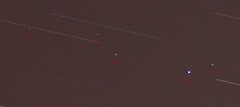Sky too bright for deep sky work, and seeing not good enough for Mars or moon.
Reticle batteries dead - Energizer 357 Button Cell Battery ?
Clear, accurate moon data is at below site:
Sun and Moon Data, Stony Ridge - and synthetic image of the Moon ("on following day")
http://cleardarksky.com/cgi-bin/sunmoondata.py?id=SROCA&tz=-8.0
The Stony Ridge telescope was running about 10% slow Friday eve, seemed less severe late in the evening. Could be case of "GLUE GREASE", like I had two years ago, picture at: http://flickr.com/photos/edhiker/62552953/
Would be nice to find a lubricant that is longer lasting, maybe:
MOLYDUVAL Soraja C 402 Synthetic Oil (PAO) Based
Transparent grease for lubrication of bearings, valves and taps. Very tacky. Strong adhesiveness. MOLYDUVAL Soraja C402 is a long-life lubricant with excellent adhesive properties.
* for lubrication of sliding surfaces in food Industry
* for slow running bearings in food Industry
* for lubrication if extreme cleanness is desired
* for packing machinery in the food Industry
-35°C up to 160°C, shortly +200°C http://www.mos2.com/data/cat/doc/en/soraja.doc.
Soraja C 403 Same as Soraja C 402, but harder, NLGI 3
.... but a nice setup, sure nicer than being outdoors in the winter.
